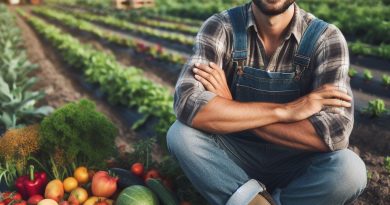Agroforestry: Farms and Forests
Last Updated on January 24, 2024
Introduction
Agroforestry is a farming practice that involves the integration of trees and agricultural crops on the same piece of land.
It combines both forestry and agriculture to create a sustainable and productive system.
The integration of trees in agroforestry systems offers numerous benefits to farmers and the environment.
Firstly, it improves soil fertility by fixing nitrogen and increasing organic matter content.
This leads to increased crop yields and reduced need for chemical fertilizers.
Furthermore, agroforestry systems provide shade for crops, reducing the impact of extreme weather conditions and enhancing crop resilience.
The trees also act as windbreaks, preventing soil erosion and protecting crops from damage.
Another important benefit of agroforestry is its potential to sequester carbon dioxide from the atmosphere.
Trees store carbon in their biomass, contributing to climate change mitigation.
Additionally, agroforestry systems promote biodiversity by providing habitat for various species.
Birds, insects, and other wildlife are attracted to these areas, creating a more balanced ecosystem.
Agroforestry is also economically beneficial for farmers as it diversifies their income sources.
While waiting for tree crops to mature, farmers can still harvest annual crops, providing an additional source of income.
Basically, agroforestry plays a vital role in farming.
Its integration of trees with agriculture offers numerous benefits, including improved soil fertility, increased crop resilience, carbon sequestration, biodiversity promotion, and diversified income sources.
By practicing agroforestry, farmers can create sustainable and productive farming systems.
Benefits of Agroforestry
Agroforestry offers numerous benefits that contribute to sustainable agriculture practices and environmental conservation.
This section will explore the various advantages of agroforestry, including soil conservation and erosion control, biodiversity enhancement, climate change mitigation, increased resilience to extreme weather events, and improved water management.
Soil conservation and erosion control
Soil conservation and erosion control are critical aspects of sustainable farming.
Agroforestry plays a significant role in preventing soil erosion by establishing tree cover that acts as a natural barrier.
Tree roots bind the soil together, reducing the risk of erosion caused by wind or water.
This helps maintain soil quality, fertility, and structure.
Biodiversity enhancement
Furthermore, agroforestry systems contribute to enhanced biodiversity.
By integrating trees with traditional farming practices, these systems provide a habitat for a wide range of plant and animal species.
The diverse environment supports pollinators, natural pest control, and overall ecological balance.
Climate change mitigation
Agroforestry also has a positive impact on climate change mitigation.
Trees in agroforestry systems sequester carbon dioxide from the atmosphere through photosynthesis.
This helps reduce greenhouse gas emissions, contributing to the overall effort of combating climate change.
Additionally, agroforestry contributes to better air quality and acts as a natural windbreak, reducing wind erosion.
Increased resilience to extreme weather events
Another significant benefit of agroforestry is its potential to increase resilience to extreme weather events.
With climate change causing more frequent and intense droughts, floods, and storms, farmers need resilient agricultural systems.
Agroforestry provides shade and wind protection, reducing the vulnerability of crops to extreme weather conditions.
This helps minimize crop losses and ensures the stability of farm income.
Improved water management
Agroforestry also plays a crucial role in water management.
By planting trees and incorporating them into agricultural landscapes, water runoff can be reduced, preventing soil erosion and nutrient loss.
Additionally, tree roots enhance water infiltration, allowing for better storage of water in the soil.
This helps maintain soil moisture levels, supporting crop growth even during dry periods.
Generally, agroforestry offers a range of benefits that contribute to sustainable farming, environmental conservation, and climate change mitigation.
From preventing soil erosion and enhancing biodiversity to increasing resilience to extreme weather events and improving water management, agroforestry provides a multifaceted approach to land-use practices.
By adopting agroforestry systems, farmers can reap the rewards of increased sustainability, productivity, and resilience in agriculture while preserving and enhancing the natural resources on which we rely.
Read: Farm-to-Fork: Understanding the Chain
Agroforestry Practices
In agroforestry, various practices are implemented to enhance the synergy between farms and forests.
Three common practices include alley cropping, windbreaks and shelterbelts, and silvopasture.
Alley cropping
Alley cropping involves growing trees in between rows of crops.
This practice helps prevent soil erosion and increases nutrient availability for the crops.
Suitable crops for alley cropping include maize, soybeans, and vegetables.
However, alley cropping also presents challenges.
The trees and crops may compete for resources such as water and sunlight.
Proper management is necessary to ensure that both the trees and crops thrive together.
Windbreaks and shelterbelts
Windbreaks and shelterbelts are designed to protect crops from strong winds.
Trees such as poplar, cedar, and pine are commonly used for this purpose.
These trees create a barrier that reduces wind velocity, which helps prevent wind erosion and conserve soil moisture.
Additionally, windbreaks provide habitat for beneficial insects that can control pests in the farm.
The presence of windbreaks improves overall farm productivity by safeguarding crops against wind damage.
Silvopasture
Silvopasture is a dynamic practice that combines trees and livestock in a managed grazing system.
It provides shade and shelter for livestock while also enhancing the quality of forage.
The trees offer protection from extreme weather conditions and create a more comfortable environment for the animals.
Silvopasture offers economic advantages as well. Farmers can utilize the timber produced by the trees, generating additional income.
The diversified income streams and reduced veterinary costs contribute to the economic stability of the farm.
In fact, agroforestry practices like alley cropping, windbreaks and shelterbelts, and silvopasture offer significant benefits to farmers.
By integrating trees into agricultural systems, farmers can improve soil health, protect crops, and enhance livestock management.
Agroforestry practices not only contribute to sustainable farming but also provide potential economic advantages.
Read: Seasonal Eats: What Farm-to-Table Offers

Successful Examples of Agroforestry
Case study: Agroforestry in Brazil
Brazil stands as a beacon of success in agroforestry, seamlessly blending farms and forests to foster sustainable development.
The nation’s agroforestry practices have become a model for the world, showcasing the harmonious coexistence of agriculture and forestry.
Brazil’s success in agroforestry lies in its strategic integration of crops and trees.
Smallholder farmers, particularly in the Amazon region, have embraced agroforestry systems, creating diverse landscapes that support both economic productivity and ecological balance.
The symbiotic relationship between crops and trees enhances soil fertility, reduces erosion, and mitigates the impact of climate change.
Specific examples abound, such as the integration of timber trees with conventional crops like soybeans and maize.
This agroforestry approach not only diversifies income sources for farmers but also reduces the pressure on natural forests for timber resources.
The canopy cover provided by the trees helps regulate temperature, creating microclimates that benefit both crops and livestock.
Moreover, agroforestry in Brazil has proven to be a powerful tool for biodiversity conservation.
Farmers strategically plant native tree species alongside cash crops, creating habitat corridors for wildlife.
This approach not only protects endangered species but also contributes to the overall health of the ecosystem.
Case study: Agroforestry in Nebraska, USA
In the heartland of the United States, Nebraska has embraced agroforestry as a means to enhance agricultural resilience and sustainability.
The state’s agroforestry practices exemplify how a thoughtful integration of trees into traditional farming systems can yield positive outcomes.
Nebraska’s agroforestry journey begins with a recognition of the role trees play in mitigating the impacts of extreme weather events, such as droughts and windstorms.
Farmers in the region have adopted windbreaks and riparian buffers, utilizing native tree species to shield crops from strong winds and protect water bodies from agricultural runoff.
Positive outcomes are evident in increased crop yields and reduced soil erosion.
The strategic placement of trees along field boundaries not only protects crops but also creates microclimates that foster healthier soil.
This, in turn, enhances the long-term sustainability of agricultural practices in the region.
Lessons learned from Nebraska’s agroforestry initiatives emphasize the importance of collaboration and education.
Farmers have actively engaged in extension programs and workshops, sharing knowledge and experiences.
This collaborative approach has accelerated the adoption of agroforestry practices across the state, creating a ripple effect that benefits both the environment and the farming community.
In short, the success stories of agroforestry in Brazil and Nebraska highlight the transformative potential of integrating farms and forests.
These case studies demonstrate that agroforestry is not just a concept but a practical solution, fostering a balance between agricultural production and environmental conservation.
As the world grapples with the challenges of sustainable development, these examples provide valuable insights into the positive impact of agroforestry on diverse ecosystems and communities.
Read: Eating Local: Benefits for You and Farmers
Considerations for Implementing Agroforestry
Costs and Economic Viability
- Agroforestry systems may require initial investments in land preparation, tree planting, and infrastructure.
- Farmers must consider the costs of maintaining trees, managing pests and diseases, and implementing conservation practices.
- However, agroforestry can provide multiple income streams, diversifying revenue sources and improving economic resilience.
- Economic viability depends on factors such as market demand, product pricing, and access to financing options.
- Farmers should conduct a comprehensive cost-benefit analysis before implementing agroforestry on their farms.
Policy and Regulatory Support
- Governments can play a crucial role in promoting agroforestry through supportive policies and regulations.
- Policy frameworks should incentivize farmers to adopt agroforestry by providing financial assistance, technical guidance, and legal protection.
- Regulatory support can address issues related to land tenure, tree ownership, water rights, and biodiversity conservation.
- Collaboration between government agencies, research institutions, and farming communities is essential for effective policy implementation.
- Advocacy efforts are essential to raise awareness among policymakers about the benefits of agroforestry.
Technical Knowledge and Training
- Successful agroforestry implementation requires technical knowledge and training for farmers.
- Training programs should cover tree selection, planting techniques, pruning, maintenance, and integrated pest management.
- Farmers can benefit from learning about agroforestry best practices, agroecology, and sustainable land management.
- Extension services, farmer-to-farmer knowledge sharing, and capacity building initiatives can enhance technical skills and knowledge transfer.
- Collaboration with agricultural research institutions and agricultural extension services can support continuous learning and innovation in agroforestry practices.
Potential Disadvantages and Limitations
- Agroforestry systems may have slower initial returns compared to traditional agriculture due to the time required for trees to mature.
- Farmers may face challenges in accessing suitable tree species, seeds, or planting material.
- Agroforestry systems require careful planning to ensure appropriate tree densities, spacing, and species selection to avoid competition and optimize resources.
- Management complexities, such as pruning, intercropping, and weed control, can pose challenges for inexperienced farmers.
- Farmers should carefully assess site conditions, market opportunities, and local context to minimize potential limitations and maximize the benefits of agroforestry.
In review, implementing agroforestry on farms involves considerations related to costs, economic viability, policy support, technical knowledge, and potential limitations.
Conducting a thorough cost-benefit analysis, advocating for supportive policies, acquiring technical training, and carefully addressing potential challenges can enhance the successful adoption and implementation of agroforestry practices.
Agroforestry offers a promising approach to sustainable agriculture that combines both farming and forestry to create resilient and productive systems for the benefit of farmers, ecosystems, and communities.
Read: Farmers’ Stories: Voices Behind Your Food
Conclusion
Recap of the benefits of agroforestry
Agroforestry offers numerous benefits, including improved soil health, increased biodiversity, and enhanced climate resilience.
Encouragement to farmers to consider agroforestry practices
Farmers should seriously consider incorporating agroforestry practices into their farming systems to reap its advantages.
Final thoughts on the future of agroforestry in agriculture
The future of agroforestry looks promising, as it aligns with sustainable agricultural practices and the growing demand for food security and environmental conservation.
It provides a holistic approach that merges the benefits of both farms and forests.
In a nutshell, agroforestry presents a win-win situation for farmers and the environment.
By combining trees with agriculture, farmers can diversify their income streams, improve soil fertility, conserve water, and mitigate climate change impacts.
Moreover, agroforestry promotes biodiversity and contributes to the long-term sustainability of our food systems.
It is an innovative solution that maximizes agricultural productivity while minimizing ecological footprints.
As more research and awareness on agroforestry spread, it is crucial for farmers to explore and adopt these practices to ensure a resilient and sustainable future for agriculture.
Agroforestry has the potential to revolutionize the way we approach farming, promoting landscapes that are not only productive but also beneficial to nature and society.
Let us embrace this agricultural system that incorporates both farms and forests to build a greener and more resilient world.


